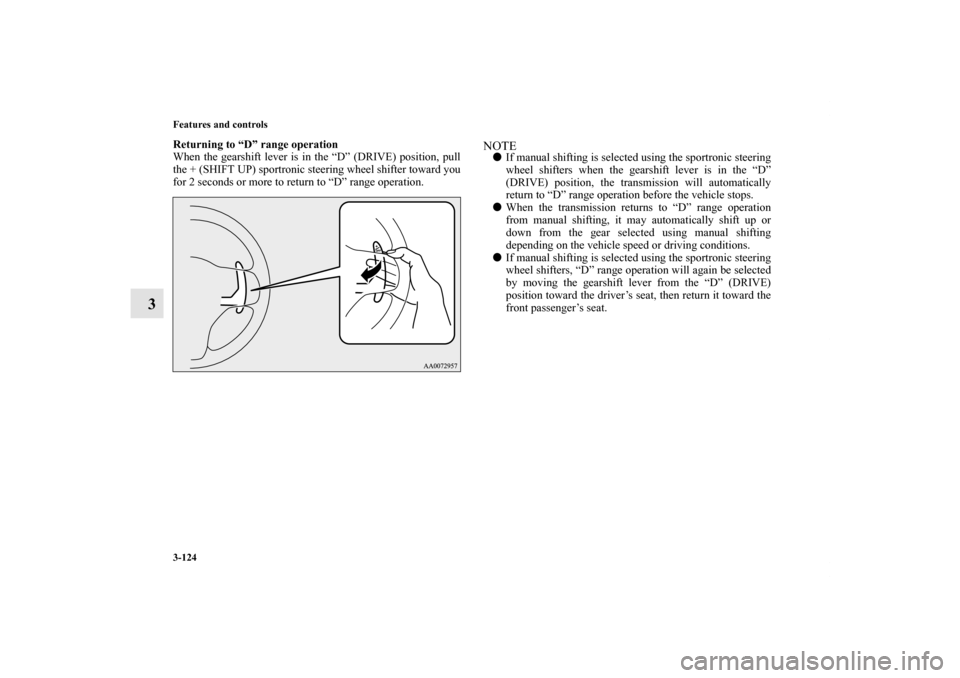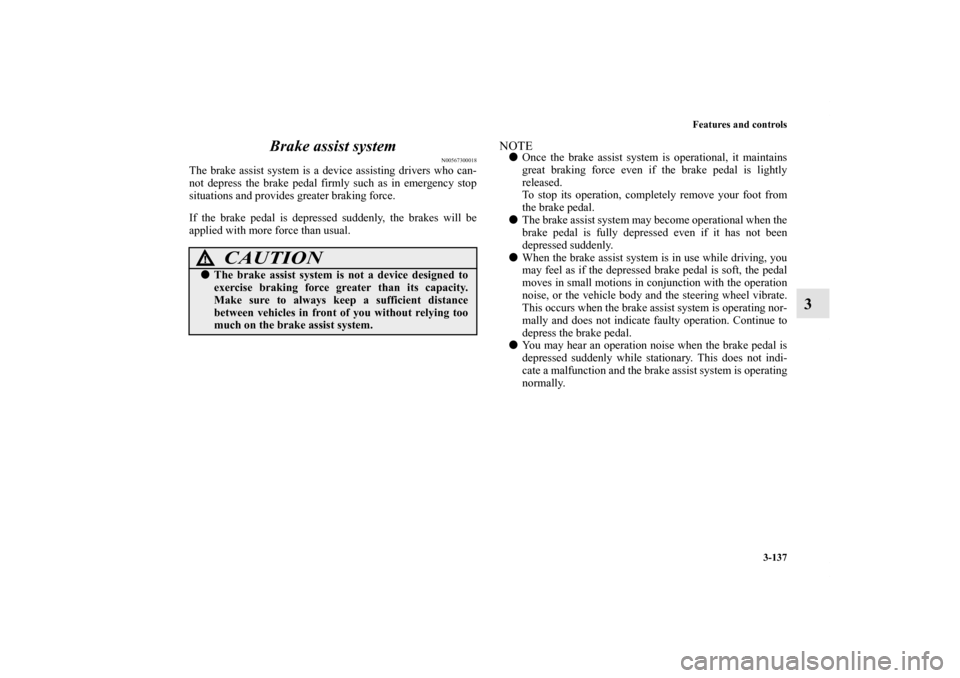Page 218 of 700
Features and controls
3-123
3
Shifting up
Each time the + (SHIFT UP) sportronic steering wheel shifter
is pulled, the transmission shifts up 1 gear.Shifting down
Each time the - (SHIFT DOWN) sportronic steering wheel
shifter is pulled, the transmission shifts down 1 gear.
NOTE�After manual shifting is selected using the sportronic
steering wheel shifters, shifting up and down can also be
performed using the gearshift lever.
BK0119300US.book 123 ページ 2010年5月21日 金曜日 午前10時13分
Page 219 of 700

3-124 Features and controls
3
Returning to “D” range operation
When the gearshift lever is in the “D” (DRIVE) position, pull
the + (SHIFT UP) sportronic steering wheel shifter toward you
for 2 seconds or more to return to “D” range operation.
NOTE�If manual shifting is selected using the sportronic steering
wheel shifters when the gearshift lever is in the “D”
(DRIVE) position, the transmission will automatically
return to “D” range operation before the vehicle stops.
�When the transmission returns to “D” range operation
from manual shifting, it may automatically shift up or
down from the gear selected using manual shifting
depending on the vehicle speed or driving conditions.
�If manual shifting is selected using the sportronic steering
wheel shifters, “D” range operation will again be selected
by moving the gearshift lever from the “D” (DRIVE)
position toward the driver’s seat, then return it toward the
front passenger’s seat.
BK0119300US.book 124 ページ 2010年5月21日 金曜日 午前10時13分
Page 224 of 700

Features and controls
3-129
3
When the gearshift lever position display is not showing
A safety device in the Twin Clutch SST has been activated due
to a possible malfunction in the Twin Clutch SST.
Refer to “If the gearshift lever position display is not showing”
on page 3-112 and follow the appropriate measures.
When warning display is showing or when no warning is
showing in the multi-information display
A safety device in the Twin Clutch SST has been activated due
to a possible malfunction in the Twin Clutch SST or in the
engine electronic control module.
Perform the following procedure.
1. Park your vehicle in a safe place and stop the engine.
2. Restart the engine.
If the vehicle moves and accelerates normally after this proce-
dure is performed, there is no malfunction in the transmission.
However, if the vehicle does not move or accelerate normally,
or if this problem occurs repeatedly, have the vehicle checked
by an authorized Mitsubishi Motors dealer or a repair facility
of your choice as soon as possible.
All-wheel drive system
(if so equipped)
N00516400033
All-wheel drive vehicles are propelled by engine power distrib-
uted constantly and appropriately to all four wheels.
Not only does this ensure enhanced handling on dry, paved
roads but also permits better traction when driving on slippery,
wet or snow-covered roads and when moving out of mud.
These vehicles, however, are not designed for off-road use,
and are unsuitable for driving on bumpy ground that may
cause excessive strain. All-wheel drive vehicles should be
driven only under the same conditions as are suitable for ordi-
nary front-wheel drive vehicles.
CAUTION
!�When the Twin Clutch SST fluid temperature is
high, the engine idle speed when the vehicle is
stopped may increase or the vehicle will have a weak
tendency to creep.
After that, if the Twin Clutch SST fluid temperature
rises even higher, the warning display will
appear.
BK0119300US.book 129 ページ 2010年5月21日 金曜日 午前10時13分
Page 225 of 700

3-130 Features and controls
3Cautions on handling of all-wheel drive
vehicles
N00530800145
Tires and wheelsSince driving torque can be applied to all four wheels, the per-
formance of the vehicle when operating in all-wheel drive is
greatly affected by the condition of the tires.
Pay close attention to the tires.
�Install specified tires on all wheels. Refer to “Tires and
wheels” on page 9-10.
�Be sure to fit all four tires and wheels of the same size and
type.
When replacement of any of the tires or wheels is neces-
sary, replace all of them.
�All tires should be rotated whenever the wear difference
between the front and rear tires is recognizable.
Good vehicle performance cannot be expected if there is a dif-
ference in wear between tires. Refer to “Tire rotation” on page
7-35.
�Check the tire inflation pressure regularly.
CAUTION
!�Always use tires of the same size, same type, and
same brand, and which have no wear differences.
Using tires that differ in size, type, brands or the
degree of wear, will increase the differential oil tem-
perature, resulting in possible damage to the driving
system. Further, the drive train will be subjected to
excessive loading, possibly leading to oil leakage,
component seizure, or other serious problems.
BK0119300US.book 130 ページ 2010年5月21日 金曜日 午前10時13分
Page 226 of 700
Features and controls
3-131
3
Towing Jacking up a all-wheel drive vehicles
CAUTION
!�Do not tow all-wheel drive vehicles with the front or
rear wheels on the ground (Type A or Type B) as
illustrated. This could result in damage to the driv-
etrain, or unstable towing.
If you tow all-wheel drive vehicles, use Type C or
Type D equipment.
WA R N I N G
!�Do not start or run the engine while the vehicle is on
the jack.
The jack could slip out of position and result in an
accident.
BK0119300US.book 131 ページ 2010年5月21日 金曜日 午前10時13分
Page 227 of 700

3-132 Features and controls
3ACD (Active center differential system)
(if so
equipped)N00538500034
The ACD is a system that improves acceleration performance
and straight-ahead stability by regulating the differential limit-
ing action and power drive distribution of the center differen-
tial.NOTE�If the parking brake lever is pulled up while the vehicle is
moving, the center differential is designed to switch to a
free state condition which will allow the rear wheel to
lock easier.
ACD control mode
N00545400048
Select the control mode from the following three types to suit
the driving conditions.
CAUTION
!�Do not over-rely on the ACD. Even the ACD cannot
prevent the natural laws of physics from acting on
the vehicle. This system, like any other system, has
limits and cannot help you to maintain traction and
control of the vehicle in all circumstances. Reckless
driving can lead to accidents. It is the driver’s
responsibility to drive carefully. This means taking
into account the traffic, road and environmental
conditions.�Be sure to use tires that are the same specified size,
type, and brand, and have no difference in the
amount of wear for all four wheels. Otherwise, the
ACD may not work properly.
ACD control
mode
Operation
TA R M A CNormally, use this control mode. Use this
mode for paved roads.
GRAVELUse this control mode when driving on some-
what slippery road surfaces, such as wet road
surfaces and gravel roads.
SNOWUse this control mode when driving on slip-
pery road surfaces, such as snow-covered
roads.
BK0119300US.book 132 ページ 2010年5月21日 金曜日 午前10時13分
Page 230 of 700

Features and controls
3-135
3 Limited-slip differential
(if so equipped)
N00517400069
A limited-slip differential is applied for rear wheel differential.
The features of this limited-slip differential are described
below:
Just as with a conventional differential, the wheel on one side
is allowed to turn at a different speed from the wheel on the
other side when the vehicle is cornering. The difference
between the limited-slip differential and a conventional differ-
ential is that if the wheel on one side of the vehicle loses trac-
tion, a greater amount of torque is applied to the wheel on the
other side to improve traction.NOTE�Even if there is a difference in the amount of traction the
wheels can get, if both of them are spinning, the limited-
slip differential will not be effective.
Service brake
N00517500262
Brake pedalOveruse of the brake can cause poor brake response and pre-
mature wear of the brake pads and linings.
When driving down a long or steep hill, use engine braking by
downshifting.
CAUTION
!�Never start the engine while one of the front or rear
wheels is jacked up and the other in contact with the
ground; doing so may cause the vehicle to jump for-
ward.�Continuously attempting to extract the vehicle from
snow, mud, etc. while using high engine rpm may
damage the limited-slip differential.�Using a compact spare wheel will adversely affect
the limited-slip differential; replace the compact
spare wheel with a standard size wheel as soon as
possible.
WA R N I N G
!�Do not leave any objects near the brake pedal or let
a floor mat slide under it; doing so could prevent the
full pedal stroke that would be necessary in an emer-
gency. Make sure that the pedal can be operated
freely at all times. Make sure the floor mat is
securely held in place.
CAUTION
!�It is important not to drive the vehicle with your foot
resting on the brake pedal when braking is not
required. This practice can result in very high brake
temperatures, premature pad and lining wear, and
possible damage to the brakes.
BK0119300US.book 135 ページ 2010年5月21日 金曜日 午前10時13分
Page 232 of 700

Features and controls
3-137
3 Brake assist system
N00567300018
The brake assist system is a device assisting drivers who can-
not depress the brake pedal firmly such as in emergency stop
situations and provides greater braking force.
If the brake pedal is depressed suddenly, the brakes will be
applied with more force than usual.
NOTE�Once the brake assist system is operational, it maintains
great braking force even if the brake pedal is lightly
released.
To stop its operation, completely remove your foot from
the brake pedal.
�The brake assist system may become operational when the
brake pedal is fully depressed even if it has not been
depressed suddenly.
�When the brake assist system is in use while driving, you
may feel as if the depressed brake pedal is soft, the pedal
moves in small motions in conjunction with the operation
noise, or the vehicle body and the steering wheel vibrate.
This occurs when the brake assist system is operating nor-
mally and does not indicate faulty operation. Continue to
depress the brake pedal.
�You may hear an operation noise when the brake pedal is
depressed suddenly while stationary. This does not indi-
cate a malfunction and the brake assist system is operating
normally.
CAUTION
!�The brake assist system is not a device designed to
exercise braking force greater than its capacity.
Make sure to always keep a sufficient distance
between vehicles in front of you without relying too
much on the brake assist system.
BK0119300US.book 137 ページ 2010年5月21日 金曜日 午前10時13分